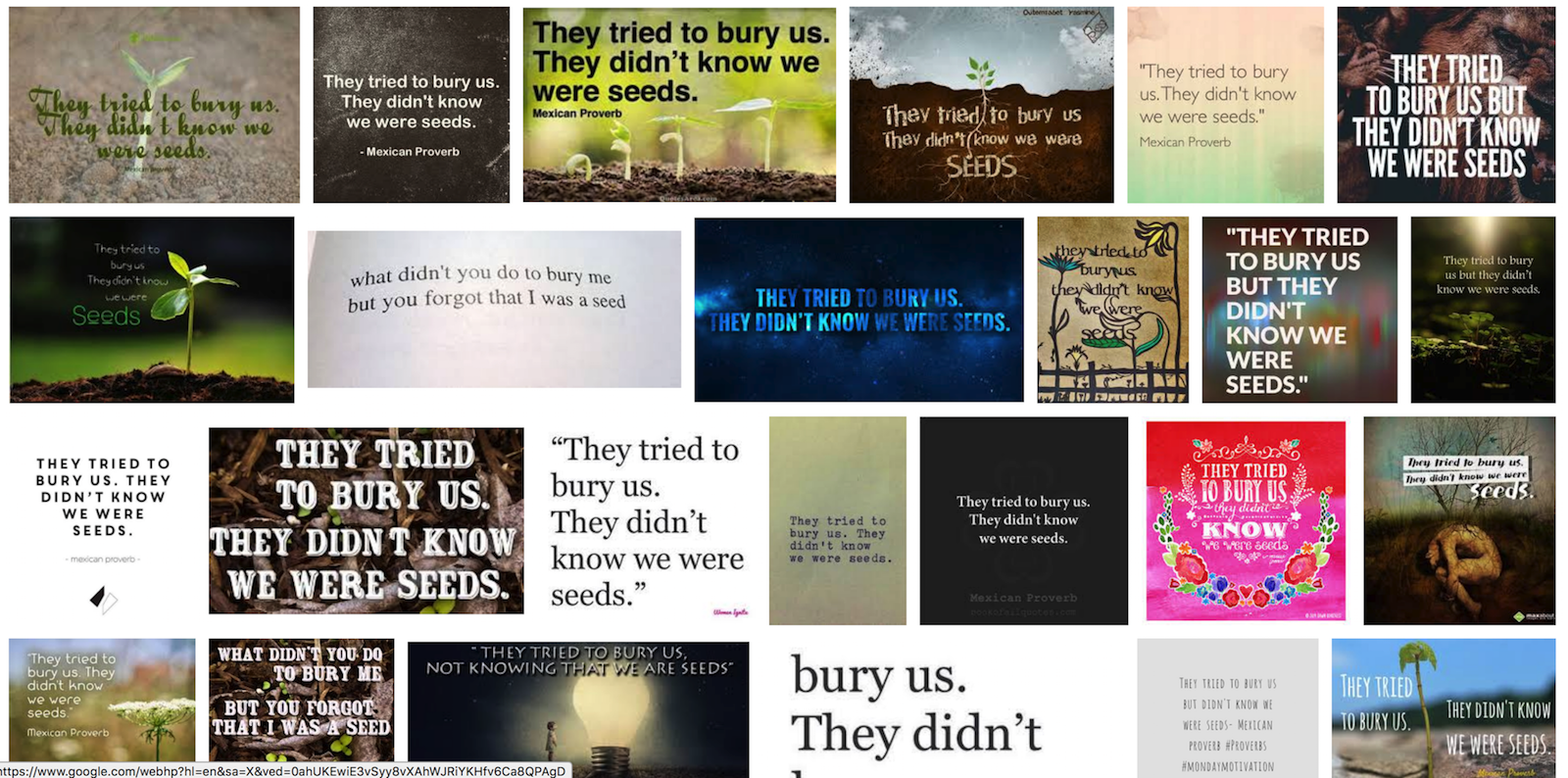Possible Titles
ICM Profundo
Somos Semillas
Seeds of Song
Computational Folk
Resistencia Folklórica Computacional
Concept
A P5 sketch. When the user sings into the microphone, they make a seed grow.
Ideal Execution
Different levels of intonation (ie. hitting high and low notes) will make the seed grow in different ways so that each iteration will be completely unique.
Inspiration
what didn’t you do to bury me
but you forgot that I was a seed
– Dinos Christianopoulos, c. 1970 (Greek poet)
Quisieron enterrarnos, pero no sabían que éramos semilla.
– Zapatista Subcomandante Insurgente Marcos, c. 2014 (symbolic leader of the EZLN, “deceased”)

– Google Image Search, “They tried to bury us”
Music is a distinctly effective vehicle for preserving culture––ways of being and knowing––through time and space and repression. I love folk music of the Americas for precisely this reason. Taking the oft paraphrased quote from above as inspiration, I would like to draw a line between what I see as the modern folk art of creative coding and the folk music traditions. Additionally, my goal is to express visually the way in which music adds materially to acts of resistance.
Son jarocho is a style of Mexican folk music from Veracruz. It’s basically what happens when you mix Spanish baroque music stylings and the rhythms of West Africa in the colonial Caribbean. It shares the diasporic musical canon with salsa, samba, rumba, bluegrass, and spirituals of the American South. Like those other styles, it has a call and response song structure and is typically performed socially in a fandango accompanied by the rhythmic dance, el zapateado.
El chuchumbé [link in Spanish] is one of the oldest known songs in son jarocho. Along with La bamba––made famous this side of the border by Ritchie Valens––it was a song of resistance and satire. It’s also catchy as hell.
I initially learned about this style of music and the history of these songs through a contemporary son jarocho band from L.A. that invokes the chicano activist history––and present––of these songs: Las Cafeteras. Both their versions of Chuchumbé and La Bamba Rebelde replace traditional lyrics with lyrics referencing the current struggles of migrants within the U.S. I’ve seen them perform many times and each time it feels as if, with the zapateado and their music, they are trying to summon a new way of being directly from the earth.
Indeed, they take a lot of inspiration for their lyrics and political philosophy from the EZLN, Ejército Zapatista de Liberación Nacional (Zapatista Army of National Liberation), an autonomous, indigenous community that, in response to the free trade agreements of the 1990s and the corrupt narco-state’s violence against rural communities, currently practices armed civil defense against the Mexican government and military in Chiapas. Through collective agriculture, education, and self-governance they keep their Mesoamerican culture and way of knowing alive. They literally plant the seeds of resistance.
Methodology
This idea came directly from the collective idea we had for ICMadness. All due credit to Chian and Alan.

In this, using p5.Amplitude, we mapped the amplitude measured from the mic input to the numbers of branches in this fractal tree we found. Here are some other sources of inspiration:
https://github.com/northcoders/p5js-examples/blob/master/fractal-tree/fractal-tree.js
Germination timelapse from Ales Kladnik on Vimeo.
A growing Bezier curve that could be used to mimic the above using bezier()?
Possible Tests/Questions
Can I recreate the ICMadness exercise using p5.FFT instead of p5.Amplitude?
Can I sing different shapes or colors depending on frequency?
Can I make my voice control different parts of a fractal tree?
Can I make a sufficiently convincing organic shape? Do I care to?
Or should I try to fake it using pre-drawn image that reveals itself as the user sings?

Leave a Reply
You must be logged in to post a comment.